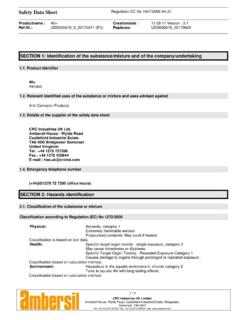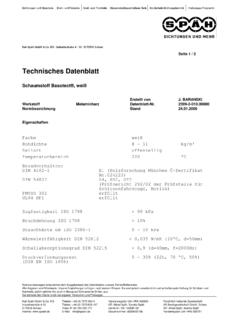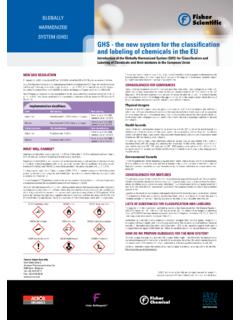Transcription of COAL TAR PITCH - nalonchem.com
1 DATE: April. 2010. EDITION: 5th . Avda. de Galicia 31 / 33005 Oviedo- Spain REVISION: 0. Phone: + / Fax: + / Telex: 84303 NAL N E. MATERIAL SAFETY DATA SHEET. (1907/2006/EC, Article 31). COAL TAR PITCH . IDENTIFICATION OF THE SUBSTANCE/PREPARATION AND OF THE. COMPANY/UNDERTAKING. Identification of the substance Trade name: Coal Tar PITCH Molecular formula: N/A. Use of the substance/preparation Binding and impregnating agent for carbon manufacturing in the aluminium and graphite industries. Company/undertaking identification Industrial Qu mica del Nal n, Avda. Galicia 31. E-33005 Oviedo Spain Tel: +34 Fax: +34 (See item Contact ).
2 Emergency information Tel: +34 Fax: +34 Chem HAZARDS IDENTIFICATION. Hazard designation: T: Toxic (Carc. Cat. 2). Information concerning particular hazards for human and environment R45: May cause cancer R46: May cause heritable genetic damage R60: May impair fertility R61: May cause harm to the unborn child R52/53: Harmful to aquatic organisms, may cause long-term adverse effects in the aquatic environment May cause thermal burns if molten, because of the high temperature. The classification is according to the latest editions of the EC-lists, and extended by company and literature data.
3 COMPOSITION / INFORMATION ON INGREDIENTS. Chemical Description The main product from the distillation of high temperature coal tar. A black solid with an approximate softening point from 30 C to 180 C. Composed primarily of a complex mixture of mainly three or more condensed-ring aromatic hydrocarbons. IUPAC Name N/A. CAS Number 65996-93-2 PITCH , coal-tar, high temperature Identification Number (s). EINECS Number: 266-028-2. Index Number: 648-055-00-5. 2 / 12. Chem Dangerous Components CAS: 65996-93-2 PITCH , coal tar, high-temp. ca. 100%. EINECS: 266-028-2 PBT; Carc. Cat 2; T; R45.
4 CAS: 91-20-3 Naphthalene, pure < EINECS: 202-049-5 Carc. (R40), Xn (R22), N (R50/53). CAS: 56-55-3 Benz[a]anthracene < EINECS: 200-280-6 T-Carc. Cat. 2 (R45), N (R50/53). CAS: 218-01-9 Chrysene < EINECS: 205-923-4 T - Carc. Cat. 2 (R45) - Muta. Cat. 3 (R68), N (R50/53). CAS: 205-99-2 Benzo[b]fluoranthene, benz(e)acephenanthrylene < EINECS: 205-911-9 T-Carc. Cat. 2 (R45), N (R50/53). CAS: 207-08-9 Benzo[k]fluoranthene < EINECS: 205-916-6 T-Carc. Cat. 2 (R45), N (R50/53). CAS: 205-82-3 Benzo[j]fluoranthene < EINECS: 205-910-3 T-Carc. Cat. 2 (R45), N (R50/53). CAS: 50-32-8 Benzo[a]pyrene < EINECS: 200-028-5 T - Carc.
5 Cat. 2 (R45) - Muta. Cat. 2 (R46) - Repr. Cat. 2 (R60, R61), R43, N (R50/53). CAS: 192-97-2 Benzo[e]pyrene < EINECS: 205-892-7 T-Carc. Cat. 2 (R45), N (R50/53). CAS: 92-52-4 Biphenyl < EINECS: 202-163-5 Xi (R36/37/38), N (R50/53). CAS: 53-70-3 Dibenz[a,h]anthracene < EINECS: 200-181-8 T-Carc. Cat. 2 (R45), N (R50/53). Additional information: PITCH , coal tar, high temp. (CAS 65996-93-2) was listed on 13 January 2010 as authorisation candidate according to Art. 59(1,10) of the REACH Regulation No. 1907/2006 after classification as PBT. substance. The legality of the PBT- classification is challenged by industry and currently reassessed by the General Court, Luxembourg (Case T-93/10).
6 3 / 12. Chem FIRST - AID MEASURES. IN ALL CASES, SEEK MEDICAL ATTENTION IMMEDIATELY. REMOVE ANY CONTAMINATED CLOTHING (EXCEPT WHEN IN CONTACT WITH MOLTEN. PRODUCT). REMOVE SUBJECT FROM ANY EXPOSURE SOURCE. After inhalation: Remove subject from exposure area to fresh air. Administer oxygen or artificial respiration in severe cases. After skin contact: Remove all contaminated clothing (except when in contact with molten product). Flush skin immediately with large amounts of cold water. If solid, wash exposed area with non abrasive soap and water. After eye contact: Flush open eyes immediately with plenty of water for at least 15 minutes.
7 Then consult doctor. After ingestion: If conscious, first try to induce vomiting and then give copious quantities of water. Do not give anything by mouth to an unconscious person. Get medical help immediately. FIRE - FIGHTING MEASURES. Extinguishing media: Suitable: Dry chemicals, carbon dioxide, sand, foam, steam or water fog. Not Suitable: Water jet (may spread fire). Special hazards caused by the material, its products of combustion or resulting gases Incomplete combustion in a fire may result in a release of toxic carbon monoxide (CO), under certain fire conditions, traces of other toxic gases cannot be excluded such us Nitrogen oxides (NOx) or Sulphur dioxide (SO2).
8 Coal Tar PITCH when heated generates vapours that may ignite. Protective equipment Full-body protective clothing, including breathing apparatus. Do not inhale combustion gases. Additional information Cool storage containers with water spray jet. 4 / 12. Chem ACCIDENTAL RELEASE MEASURES. Personal Precautions: Wear full-body, industrial-type work clothing, including chemical resistant gloves, boots and goggles (face shields if molten). Use breathing protections against the effects of fumes/dust/aerosol. If liquid, avoid breathing vapours or contact with skin and eyes. Ventilate the area if the spill occurs indoors.
9 Keep away from ignition sources. Environmental Precautions: Keep away from drains, surface- and ground-water and soil. Avoid any dusting. Inform respective authorities in case of seepage into water course/sewage system. Cleaning up methods: If liquid, contain with sand, earth or any other inert material and allow to solidify. To remove solid PITCH , use mechanical means. Containers should be sealed and labelled. Dispose of contaminated material and waste according to item Ensure adequate ventilation. HANDLING AND STORAGE. Handling: Practice special caution when handling this product.
10 All work must be organized and carried out according to regulations regarding safe handling of carcinogenic substances and products. When handling liquid PITCH , avoid any foaming by using only dry containers. Use nitrogen and avoid fumes or vapours generation when working with scrubbing systems. Splashes to the skin should be prevented since will cause dermal thermal burns. Handle solid PITCH in such a way to minimize dust generation. Ensure adequate ventilation and guard against ignition sources and static electricity. Use chemical resistant gloves (heat resistant gloves if molten) and safety glasses.



